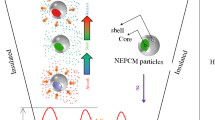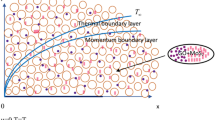Abstract
The effects of the strain rate, equivalence ratio, and particle diameter on the combustion of a mixture of aluminum microparticles with air under fuel-lean conditions are studied in the counterflow configuration with an approximate analytical perturbation method. The flame structure is assumed to consist of three zones: preheating, flame, and post-flame zones. Reasonable agreement between the current results and experimental data is obtained in terms of the flame temperature. The dimensionless ignition and ultimate flame temperatures, place of the flame starting point, and flame thickness are obtained as functions of the strain rate for different particle diameters and equivalent ratios. The results indicate that the ignition and ultimate flame temperatures and also the flame thickness decrease with increasing strain rate. With a decrease in the strain rate, the length of the preheating zone increases. With increasing particle diameter, the flame thickness increases, whereas the ignition and ultimate flame temperatures decrease. An increase in the equivalence ratio causes an increase in the ultimate flame temperature and reduction of the preheating zone and flame thickness.
Similar content being viewed by others
References
K. P. Brooks and M. W. Beckstead, “Dynamics of Aluminum Combustion,” J. Propul. Power 11, 769–780 (1995).
M. K. King, “Aluminum Combustion in a Solid Rocket Motor Environment,” Proc. Combust. Inst. 32, 2107–2114 (2009).
Y. Feng, Z. Xia, L. Huang, and X. Yan, “Experimental Investigation on the Combustion Characteristics of Aluminum in Air,” Acta Astronaut. 129, 1–7 (2016).
J. F. Guery, I. S. Chang, et al., “Solid Propulsion for Space Applications: An Updated Roadmap,” Acta Astronaut 66, 201–219 (2010).
E. L. Dreizin, “Experimental Study of Stages in Aluminium Particle Combustion in Air,” Combust. Flame 105, 541–556 (1996).
J. Sun, R. Dobashi, and T. Hirano, “Structure of Flames Propagating through Aluminum Particles Cloud and Combustion Process of Particles,” J. Loss Prevent. Process Ind. 19, 769–773 (2006).
Z. Chen and B. Fan, “Flame Propagation Through Aluminum Particle Cloud in a Combustion Tube,” J. Loss Prevent. Process Ind. 18, 13–19 (2005).
A. P. Il’in, A. A. Gromov, V. I. Vereshchagin, et al., “Combustion of Ultrafine Aluminum in Air,” Fiz. Goreniya Vzryva 37 (6), 56–60 (2001) [Combust., Expl., Shock Waves 37 (6), 664–668 (2001)].
G. Joulin, “Asymptotic Analysis of Non-Adiabatic Flames, Heat Losses Towards Small Inert Particles,” Proc. Combust. Inst. 18, 1395–1404 (1981).
Y. S. Kwon, A. A. Gromov, A. P. Il’in, et al., “The Mechanism of Combustion of Superfine Aluminum Powders,” Combust. Flame 133, 385–391 (2003).
E. L. Dreizin, “On the Mechanism of Asymmetric Aluminum Particle Combustion,” Combust. Flame 117, 841–850 (1999).
M. W. Beckstead, “Correlating Aluminum Burning Times,” Fiz. Goreniya Vzryva 41 (5), 55–69 (2005) [Combust., Expl., Shock Waves 41 (5), 533–546 (2005)].
E. L. Dreizin, “Experimental Study of Aluminum Particle Flame Evolution in Normal and Micro-Gravity,” Combust. Flame 116, 323–333 (1999).
P. Julien, J. Vickery, S. Whiteley, et al., “Effect of Scale on Freely Propagating Flames in Aluminum Dust Clouds,” J. Loss Prevent. Process Ind. 36, 230–236 (2015).
S. Goroshin, M. Bidabadi, and J. H. S. Lee, “Quenching Distance of Laminar Flame in Aluminum Dust Clouds,” Combust. Flame 105, 147–160 (1996).
S. Goroshin, M. Kolbe, and J. H. S Lee, “Flame Speed in a Binary Suspension of Solid Fuel,” Proc. Combust. Inst. 28 (2), 2811–2817 (2000).
Y. Huang, G. A. Risha, V. Yang, and R. A. Yetter, “Effect of Particle Size on Combustion of Aluminum Particle Dust in Air,” Combust. Flame 156, 5–13 (2009).
Y. Huang, G. A. Risha, V. Yang, and R. A. Yetter, “Combustion of Bimodal Nano/Micron-Sized Aluminum Particle Dust in Air,” Proc. Combust. Inst. 31, 2001–2009 (2007).
J. Daou, “Strained Premixed Flames: Effect of Heat-Loss, Preferential Diffusion and Reversibility of the Reaction,” Combust. Theory Model. 15, 437–454 (2011).
R. W. Thatcher and E. AlSarairah, “Steady and Unsteady Flame Propagation in a Premixed Counterflow,” Combust. Theory Model. 11, 569–583 (2007).
H. Y. Wang, W. H. Chen, and C. K. Law, “Extinction of Counterflow Diffusion Flames with Radiative Heat Loss and Nonunity Lewis Numbers,” Combust. Flame 148, 100–116 (2007).
J. Camacho, A. V. Singh, W. Wang, et al., “Soot Particle Size Distributions in Premixed Stretch-Stabilized Flat Ethylene–Oxygen–Argon Flames,” Proc. Combust. Inst. 36 (1), 1001–1009 (2017).
F. El-Mahallaway and S. El-Din Habik, Fundamentals and Technology of Combustion (Elsevier, 2002).
R. H. Rand and D. Armbruster, Perturbation Methods, Bifurcation Theory and Computer Algebra (Springer, 1987).
A. H. Nayfeh, Introduction to Perturbation Techniques (John Wiley and Sons, 1993).
C. Badiola, R. J. Gill, and E. L. Dreizin, “Combustion Characteristics of Micron-Sized Aluminum Particles in Oxygenated Environments,” Combust. Flame 158, 2064–2070 (2011).
Author information
Authors and Affiliations
Corresponding author
Additional information
Original Russian Text © Ya. Pourmohammad, M. Sabzpooshani.
Published in Fizika Goreniya i Vzryva, Vol. 54, No. 6, pp. 59–67, November–December, 2018.
Rights and permissions
About this article
Cite this article
Pourmohammad, Y., Sabzpooshani, M. Influence of the Strain Rate, Particle Size, and Equivalence Ratio on the Combustion of the Premixed Air–Aluminum Microparticle Mixture with a Counterflow Structure. Combust Explos Shock Waves 54, 681–688 (2018). https://doi.org/10.1134/S0010508218060072
Received:
Revised:
Published:
Issue Date:
DOI: https://doi.org/10.1134/S0010508218060072




